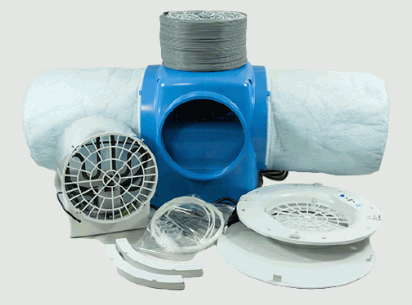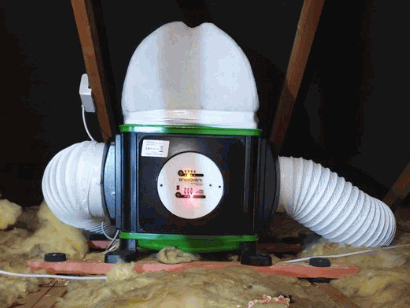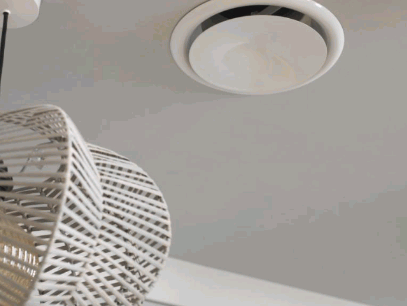
Millions of homeowners and landlords across the UK are in a seemingly endless battle against condensation, black mould, and damp issues. The problem is caused by moisture in the air that settles on cold surfaces, causing condensation and, very often, serious mould problems.
It's impossible to get an accurate figure on this, as each source has its ways and means of collecting the data, but it's safe to say it's a major problem, particularly in social housing premises and older homes.
Whatever the true figure (and it's likely to be much higher than estimates suggest), people affected by this blight are looking for effective solutions, and that's when professionals like the PIV Team can help.
Thousands of consumers have discovered that a PIV unit works wonders, but others have yet to commit themselves. If you're in the second group, you're probably wondering if PIV systems live up to the hype.
In this short blog, we hope to reveal the facts so you can decide for yourself.
We should begin with a brief reminder of what PIV is before we explore the benefits, along with any drawbacks.

PIV is a whole-house ventilation system that draws fresh, filtered air from the outside and gently distributes it throughout your home to improve the quality of the air. This constant supply of fresh air helps to remove stagnant air, reducing humidity, eliminating condensation, and preventing the buildup of harmful pollutants, dust mite allergens, mould spores, and VOCs (volatile organic compounds).
It's a great way to tackle the problem of condensation forming on cold surfaces without having to open windows in the winter months and let all that cold air in!
Uncover more: What Is A PIV Unit

When you switch on an extractor fan, it sucks air from the room, creating a slightly negative pressure. A positive input ventilation system, on the other hand, draws fresh air from outside and pushes it into the property, creating positive pressure that forces stale air through trickle vents and other gaps in the building fabric.
The positive air pressure inside the home is created using a slow-moving fan set inside a sealed unit, usually situated within the loft space (and occasionally on an outside wall).
A PIV system typically comprises the following components:
This can operate all year round to maintain a consistent supply of fresh air and a healthy indoor environment.
Learn more: How Does A PIV Unit Work
In our experience, they are highly effective, and the happy PIV Team customers would agree! These systems have helped countless consumers overcome condensation issues and improve air quality in their homes.
But don't just take our word for it: independent studies have shown that PIV can effectively reduce indoor humidity levels, dramatically reduce condensation (if not eliminate it altogether), and improve indoor air quality. For instance, a study published in the journal "Building and Environment" found that PIV reduced indoor humidity by up to 30% and eliminated condensation in 90% of homes studied.

This is probably the part that most people are interested in - if PIV units are very expensive, it's hard to argue in favour of them is worth the investment!
As it happens, they're pretty reasonably priced, generally speaking.
While the PIV units themselves vary in price between £300 and £2000 (for a very high-end heated unit), the average cost, including installation, is roughly between £500 and £1000.
Of course, you need a PIV system that is adequate for the space, and the larger the system, the higher the cost. It's also worth noting that models with a heater will be more expensive, but these aren't always necessary, depending on the type of property. Also, this will go against the PIV unit's low energy credentials, as a heated unit will consume significantly more energy.
However, when you consider the amount of damage condensation, mould, and dampness can do over time to clothes, personal belongings, furniture, and the physical structure of your home, it's a small price to pay. Also, black mould can trigger allergies, asthma, and other respiratory problems, and when it comes to looking after the health of your loved ones, it's impossible to put a price on this.
Uncover more: PIV Unit Installation Cost
We also need to factor in the running costs of a PIV unit if we're going to offer a fair assessment.
Current data suggests that it costs an average of between 1-2p per day! This is cheaper than a mechanical ventilation system with heat recovery (MVHR), which comes in at around 15p per day.
On the subject of MVHR systems, they generally cost between £2000 to £4000 for professional installation, so you can see that they're already more expensive than PIV.
We've highlighted a few of these already, but it's worth listing them in full for the purposes of discovering whether PIV units are worth it or not:
Dig Deeper: Health Benefits Of PIV Units
PIV systems effectively remove stale, recirculated air from the home, replacing it with fresh and filtered air from the outside. This process helps to eliminate pollutants, allergens, and volatile organic compounds (VOCs), leading to a healthier and more invigorating indoor environment.

Stale, humid air is a breeding ground for mould and mildew, which can cause respiratory problems and structural damage to homes. PIV units actively circulate air throughout the home, preventing stagnation and promoting the evaporation of moisture, effectively minimising the risk of dampness and mould growth.
Explore: How To Get Rid Of Mould Permanently
By preventing stale air from re-circulating, PIV can help to reduce the energy consumption of heating and cooling systems. They also 'pre-warm' colder air, so your heating system doesn't have to work as hard. This means lower energy bills and a more sustainable approach to home comfort.
The improved indoor air quality and reduced levels of allergens associated with PIV units can significantly benefit individuals with asthma or allergies. This can lead to improved respiratory health and a reduced reliance on medication.
PIV systems can help to distribute heat more evenly throughout the home, reducing hot spots and cold spots. This can improve thermal comfort and reduce the energy consumption of heating systems.
By removing moisture from the air, PIV systems can help to prevent condensation on windows, which can be unsightly and contribute to mould growth. This is especially beneficial in humid environments.
Delve into: What Causes Condensation On Windows
PIV units are typically equipped with timers and sensors that allow homeowners to adjust their operation based on their needs and preferences. This flexibility ensures that the system operates effectively while minimising energy consumption.
All things considered, it's fair to say that a PIV system is worth it, considering all the plus points, and the PIV Team stands behind this 100%.
It's relatively simple to fit in existing homes and is one of the most cost-effective solutions for improving the quality of the air in living spaces.
Even so, as we wind up our blog, it's fair to say that they're not always the best solution (especially for airtight 'green homes'), and you may need a different method. So, always check with the experts before going ahead. And when you need advice, the PIV Team experts are ready to help you find the right answer.
